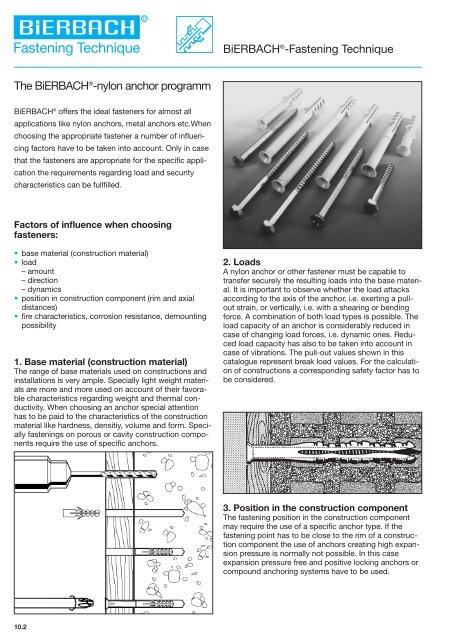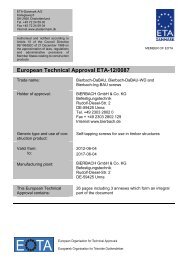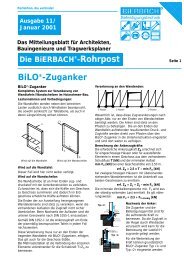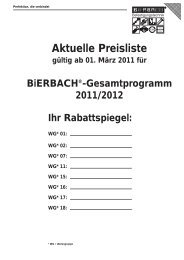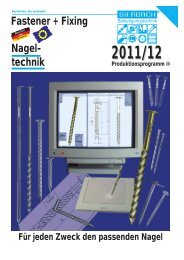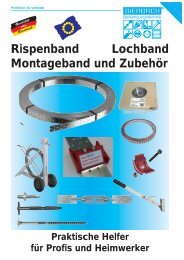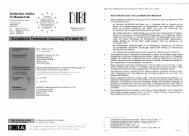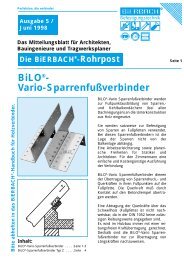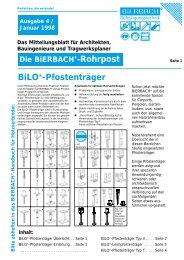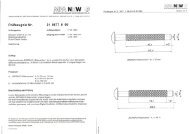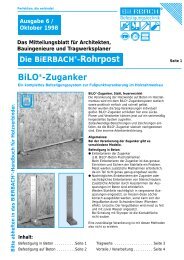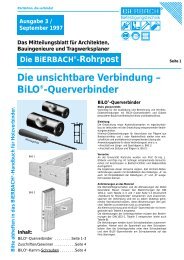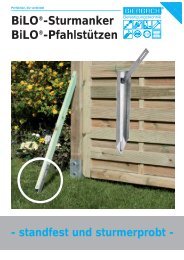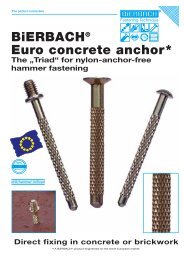A C 2 x screw à  B - BiERBACH GmbH & Co. KG Befestigungstechnik
A C 2 x screw à  B - BiERBACH GmbH & Co. KG Befestigungstechnik
A C 2 x screw à  B - BiERBACH GmbH & Co. KG Befestigungstechnik
You also want an ePaper? Increase the reach of your titles
YUMPU automatically turns print PDFs into web optimized ePapers that Google loves.
Fastening Technique<br />
The <strong>BiERBACH</strong> ® -nylon anchor programm<br />
<strong>BiERBACH</strong> ® offers the ideal fasteners for almost all<br />
applications like nylon anchors, metal anchors etc.When<br />
choosing the appropriate fastener a number of influen-<br />
cing factors have to be taken into account. Only in case<br />
that the fasteners are appropriate for the specific appli-<br />
cation the requirements regarding load and security<br />
characteristics can be fullfilled.<br />
Factors of influence when choosing<br />
fasteners:<br />
• base material (construction material)<br />
• load<br />
– amount<br />
– direction<br />
– dynamics<br />
• position in construction component (rim and axial<br />
distances)<br />
• fire characteristics, corrosion resistance, demounting<br />
possibility<br />
1. Base material (construction material)<br />
The range of base materials used on constructions and<br />
installations is very ample. Specially light weight materials<br />
are more and more used on account of their favorable<br />
characteristics regarding weight and thermal conductivity.<br />
When choosing an anchor special attention<br />
has to be paid to the characteristics of the construction<br />
material like hardness, densitiy, volume and form. Specially<br />
fastenings on porous or cavity construction components<br />
require the use of specific anchors.<br />
10.2<br />
R<br />
<strong>BiERBACH</strong> ® -Fastening Technique<br />
2. Loads<br />
A nylon anchor or other fastener must be capable to<br />
transfer securely the resulting loads into the base material.<br />
It is important to observe whether the load attacks<br />
according to the axis of the anchor, i.e. exerting a pullout<br />
strain, or vertically, i.e. with a shearing or bending<br />
force. A combination of both load types is possible. The<br />
load capacity of an anchor is considerably reduced in<br />
case of changing load forces, i.e. dynamic ones. Reduced<br />
load capacity has also to be taken into account in<br />
case of vibrations. The pull-out values shown in this<br />
catalogue represent break load values. For the calculation<br />
of constructions a corresponding safety factor has to<br />
be considered.<br />
3. Position in the construction component<br />
The fastening position in the construction component<br />
may require the use of a specific anchor type. If the<br />
fastening point has to be close to the rim of a construction<br />
component the use of anchors creating high expansion<br />
pressure is normally not possible. In this case<br />
expansion pressure free and positive locking anchors or<br />
compound anchoring systems have to be used.


